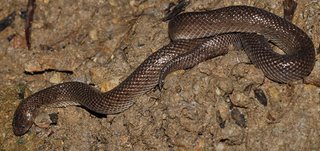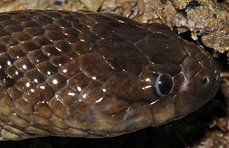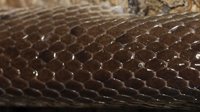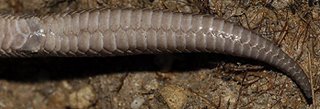 Two Crab-eating Water Snakes (Fordonia leucobalia) were sighted in Pasir Ris Park Mangrove Swamp on 19 August 2006, 9 pm. One snake was lying on the mudflat while the other was found on a mud lobster mound. My first encounter with this species was when I was part of a volunteering team "Snakehunters" led by a group of American biologists (Daryl Karns, Harold Voris & Bruce Jayne) researching on the ecology of homalopsines (A group of snakes that includes Fordonia leucobalia, Cantoria violacea, Gerarda prevostiana, and Cerberus rynchops) in Pasir Ris Park Mangrove Swamp in 2001. This study was published in our local biodiversity journal Raffles Bulletin of Zoology in 2002 [pdf, 1390 kb].
Two Crab-eating Water Snakes (Fordonia leucobalia) were sighted in Pasir Ris Park Mangrove Swamp on 19 August 2006, 9 pm. One snake was lying on the mudflat while the other was found on a mud lobster mound. My first encounter with this species was when I was part of a volunteering team "Snakehunters" led by a group of American biologists (Daryl Karns, Harold Voris & Bruce Jayne) researching on the ecology of homalopsines (A group of snakes that includes Fordonia leucobalia, Cantoria violacea, Gerarda prevostiana, and Cerberus rynchops) in Pasir Ris Park Mangrove Swamp in 2001. This study was published in our local biodiversity journal Raffles Bulletin of Zoology in 2002 [pdf, 1390 kb].Ten years after the description of Fordonia leucobalia in 1837, Theodore Cantor recognized that F. leucobalia ate crabs, thus its common name (Murphy & Voris, 2002). Alan Savitzky (1983) suggested that this snake uses its jaws to crush crabs. John Murphy and Harold Voris (2002), however, found that the carapace always remained intact when F. leucobalia consumed hard-shelled crabs. Richard Shine and Terry Schwaner (1985) observed this species using an unusual form of constriction while feeding on crabs and removing and eating each of the crab's legs. By using the same method, F. leucobalia teared apart carapaces of very large soft shelled crabs (Murphy & Voris, 2002).
John Murphy and Harold Voris (2002) described the unique feeding strategy of Fordonia leucobalia:
"Small crabs were simply seized and swallowed with the strike, but larger crabs were handled in a different manner. The snake struck at the crab with a closed mouth, but instead of grabbing the crab in its jaws it slapped the crab with its chin. The crab, apparently realized it was under attack, withdrew its legs and sunk into the substrate into a defensive posture. The snake then went to work swallowing the crab sideways. Large crabs that resist predation may end up having the snake chewing on one of its legs, and as the crab tires, it may eject the leg to escape, leaving only a small piece of itself as a morsel for the snake."
This midly-venomous snake possesses massive fangs that look like nail punches built to puncture the hard chitinous exoskeleton of crabs (Murphy & Voris, 2002).
Cox et al. (1998) claimed that this species not only preys on crabs, but also on small fish.
Litters of 6-15 young, each 18 cm long, are known (Cox et al., 1998). Adults can grow up to 94 cm (Cox et al., 1998).
This nocturnal snake inhabits tidal rivers and coastal areas (Cox et al., 1998). It made extensive use of mud lobster mounds, has been observed foraging on mud tidal flats, and also known to use crab burrows (Karns et al., 2002).
It occurs from Burma through southern Thailand, Malaysia, Singapore and New Guinea to northern Australia, a distribution remarkably similar to mud lobsters (Thalissina anomala) (Barrett, 1950; Cox et al., 1998; Murphy & Voris, 2002).





From left to right: Dorsal side of head; Right side of head; Dorsal side of body; Ventral side of body; Ventral side of tail.
* All photographs by Chan Kwok Wai
* All photographs by Chan Kwok Wai
REFERENCES
Barrett, C., 1950. Reptiles of Australia: crocodiles, snakes and lizards. Cassel & Company Limited, p. 113.
Cox, M. J., van Dijk, P. P., Nabhitabhata, J. & Thirakhupt, K., 1998. A photographic guide to snakes and other reptiles of Peninsula Malaysia, Singapore and Thailand. New Holland Publishers (UK) Ltd, p. 39.
Jayne, B. C., Voris, H. K. & Ng, P. K. L., 2002. Snake circumvent constraints on prey size. Nature 418: 413.
Murphy, J. C. & Voris, H. K., 2002. Aquatic snakes with crustacean-eating habits elude herpetologists for two centuries. Litteratura Serpentium 22(3): 107-114.
Savitzky, A. H., 1983. Coadapted character complexes among snakes: fossoriality, piscivory, and durophagy. American Zoologist 23: 397-409.
Shine, R. & Schwaner, T., 1985. Prey constriction by venomous snakes: a review and new data on Australian species. Copeia 1985(4): 1067-1071.
視訊交友網 080視訊聊天室 ※免費視訊聊天室※ ※免費視訊聊天室※ 視訊聊天室 成人影音視訊聊天室 ut影音視訊聊天室 ※免費視訊聊天室※ 視訊ukiss聊天室視訊ukiss聊天室 視訊交友90739 視訊交友90739 情人視訊網 168視訊美女 168視訊美女 168視訊美女 視訊美女館 視訊美女館 免費視訊美女網 小高聊天室 小高聊天室 aio交友聊天室 aio交友聊天室 交友聊天室 交友聊天室 線上a片 線上a片 線上a片 線上a片 線上a片 免費線上a片 免費線上a片 嘟嘟成人網站 成人漫畫 情色文學 嘟嘟成人網 成人貼圖區 情色文學成人小說 微風成人區 情色貼圖區 免費視訊聊天 免費成人圖片區 愛情公寓 愛情公寓聊天室 寄情築園小遊戲 免費aa片線上看 aa片免費看 情色SXE聊天室 SEX情色遊戲 色情A片 免費下載 av女優 俱樂部 情色論壇 辣妹視訊 情色貼圖網 免費色情 聊天室 情人視訊聊天室 免費a片成人影城 免費a片-aa片免費看 0204貼圖區 SEX情色 交友聊天-線上免費 女優天堂 成人交友網 成人情色貼圖區 18禁 -女優王國 080視訊美女聊天室 080視訊聊天室 視訊交友90739 免費a片 aio 視訊交友網 成人影城-免費a片※免費視訊聊天※85cc免費影片日本線上免費a片 免費色咪咪影片免費色咪咪影片aaa片免費看影片aaa片免費看成人影城情人視訊高雄網sex520免費影片080聊天室080聊天室aa的滿18歲影片免費av18禁影片免費av18禁影片免費av18禁影片aa的滿18歲影片聊天室ut愛情公寓尋夢園聊天室視訊交友網免費av18禁影片av女優
ReplyDelete